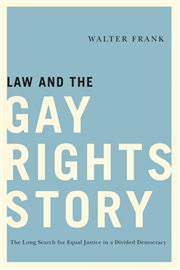 Law and the Gay Rights Story: The Long
Law and the Gay Rights Story: The Long
Search for Equal Justice in a Divided Democracy
by Walter Frank
Rutgers University Press. 248 pages, $29.95
READING Walter Frank’s Law and the Gay Rights Story the same week the U.S. Supreme Court declined to consider several Circuit cases that upheld marriage equality has been a timely and satisfying coincidence. By retelling the story of the gay rights movement as a case study of American Constitutional process and democracy, Frank implies that the Court’s current strategic silence will bring the gay marriage issue to a final resolution—one that will ultimately result in a positive outcome in the evolution of gay rights.
The book is a highly readable sociopolitical and legal history that intends “to bridge the divide between legal scholarship and the work of journalists and historians.” It does this by viewing gay rights reform against “the broad canvas of gay history, filled with deeply personal drama.” Frank skillfully weaves together just enough of the concepts and nuances of the law with lively tales of gays and lesbians emerging from the shadows to make for an engrossing story of how activists asserted their rights in the streets, in the courts, and in legislative lobbies. Moreover, he describes how legal ideas were formed, sharpened, and advanced by focused political organization and coalition building, by careful lawyering and noisy activism, by smart public relations and media management, and by the engagement of gay and lesbian citizens working within the federal system.
The book is written in two parts. The first part presents the history of the gay rights movement chronologically, fitting the key laws and court cases into the flow of political and social action at each stage. The second part presents the issues the gay civil rights movement has had to confront in order of subject matter: sodomy laws; discrimination in the military and the workplace; bullying, gay straight alliances, and gay speech in the school system; adoption, child custody, and same-sex marriage. Frank describes step-by-step how the lawyers, judges, lobbyists, and legislators involved in each of these issues adapted the principles of due process, equal protection, free speech, and fundamental fairness to specific cases. This sequential presentation carries the layperson through the complexity of constitutional law without ever becoming obscure or boring. On the contrary, by repeatedly applying the same constitutional concepts to the various kinds of legal cases Frank writes about—public versus private cases, cases involving children versus adults, and so on—the book serves as an excellent primer on constitutional dynamics.
What’s more, by writing in a consistently accessible, nonacademic style, Frank achieves his goal of bridging legal analysis with historical narrative. He shows how the interplay of different groups and personalities shaped the legal ideas and provided the strategic opportunities to use the various courts, legislatures, and bureaucracies to push the law forward. Especially instructive is the social history of how each successful or failed legal milestone led to subsequent social and political action, a rethinking of strategy, and a sharpening of arguments and ideas.
The book has two potential shortcomings. First, it may disappoint readers who have been closely following the gay civil rights movement, as it is a synthesis of already published materials and does not break new ground. Second, it may seem incomplete to legal scholars because the impact of the civil rights and human rights movements on gay rights is not explored. Often it was the advancement of rights for racial and ethnic minorities, women, and the disabled that set the precedents for applying constitutional principles to gay rights.
Despite these shortcomings, Law and the Gay Rights Story is a fundamental text that offers clear and coherent explanations for the progression of advances in gay rights. It can guide and orient readers with an interest in specific subjects to primary sources and scholarly works, as well as provide the general reader with a better understanding of the system of constitutional law and the ways in which gay rights are advancing. Despite Frank’s aim of using the gay rights struggle as a case study to illustrate the evolution of constitutional law, the book does not conclude with recommendations for the future. Nonetheless, it does leave us with plenty of reasons to be optimistic.
________________________________________________________
Bill Valletta is a retired land, property rights, and international aid attorney who lives in Somerville, Mass.






Discussion1 Comment
Dear Mr. Valletta,
Thank you for your very generous and thoughtful review. You really understood exactly what I was trying to do. I agree that the book does not address the impact of legal precedents in the broader civil rights and human rights movements on gay rights cases. That may be because deep down I believe that cultural and social developments may have been more important in driving the legal results on gay rights cases, particularly in the family law and employment law areas. This is a subject, however, which I need to think more about and I appreciate your raising it. Again, thank you not only for your kind words but for what is the most lucid summary of the book’s contents I have yet seen. My e mail address is wltr.frank@gmail.com if you would like to continue this conversation.
Best,
Walter Frank